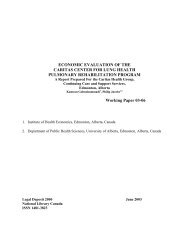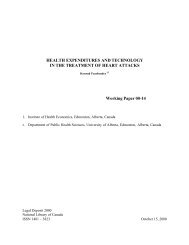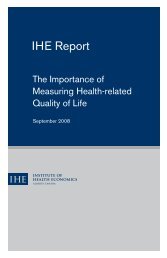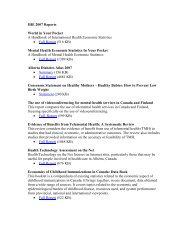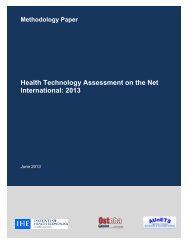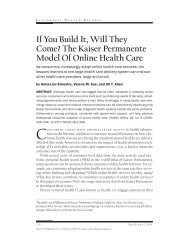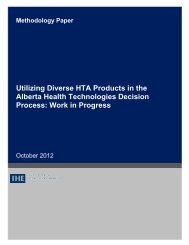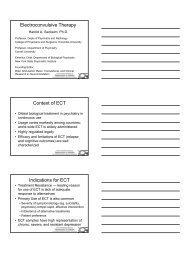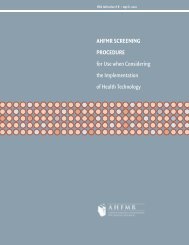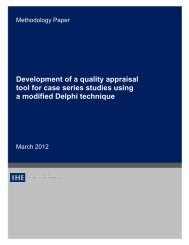Bariatric treatments for adult obesity - Institute of Health Economics
Bariatric treatments for adult obesity - Institute of Health Economics
Bariatric treatments for adult obesity - Institute of Health Economics
- No tags were found...
You also want an ePaper? Increase the reach of your titles
YUMPU automatically turns print PDFs into web optimized ePapers that Google loves.
concluded that adding orlistat to LM was associated with best value-<strong>for</strong>-money in the sub-group <strong>of</strong>obese patients with IGT.Roux et al. 21 compared the cost-effectiveness <strong>of</strong> usual care with four weight loss strategies—dietonly, diet and orlistat; diet and exercise; and a combination <strong>of</strong> diet, exercise, and behaviourmodification—<strong>for</strong> women aged ≥ 35 years with a BMI ≥ 25 kg/m 2 . A first-order Monte Carlomodel was applied to simulate the natural history <strong>of</strong> <strong>obesity</strong> over a lifetime horizon. The study wasconducted from a societal perspective in the US, with clinical evidence mainly derived from RCTs.The medical costs considered in the analysis were the costs <strong>of</strong> medication, physician services,laboratory and diagnostic tests, and the costs <strong>of</strong> <strong>obesity</strong>-related morbidity and mortality. Nonmedicalcosts such as fitness and travel costs as well as the costs <strong>of</strong> patients’ time were also included.Results indicated the treatment option with the lowest cost per life year (LY) saved or per QALYgained was the combination <strong>of</strong> diet, exercise, and behaviour modification; as compared to usual care,the cost <strong>of</strong> the combined treatment was $63,153 per LY saved and $13,174 per QALY gained. Thestudy concluded that the weight loss program combining diet, exercise, and behaviour modificationwas the most cost-effective <strong>for</strong> overweight and obese women.Hampp et al. 17 constructed a decision analytic model to assess the clinical and economic impact <strong>of</strong>rimonabant in combination with LM (LCD and exercise) <strong>for</strong> <strong>adult</strong> patients with a BMI ≥ 30 kg/m 2or a BMI ≥ 27 kg/m 2 with treated or untreated dyslipidaemia or hypertension. Five treatmentalternatives were:rimonabant at a daily dose <strong>of</strong> 20mg plus LM <strong>for</strong> 1 year;rimonabant plus LM <strong>for</strong> one year followed by placebo plus LM <strong>for</strong> 1 year;rimonabant plus LM <strong>for</strong> 2 years;placebo plus LM <strong>for</strong> 2 years; no intervention,The time horizon <strong>of</strong> the analysis was 5 years. The study applied clinical evidence demonstrated in alarge RCT and healthcare costs from a US payer’s perspective. The cost categories included the costs<strong>of</strong> medications, dietician and physician visits, and treatment <strong>for</strong> myocardial infarction and diabetes.Results indicated that rimonabant plus LM <strong>for</strong> one year and <strong>of</strong> rimonabant plus LM <strong>for</strong> 1 yearfollowed by placebo plus LM <strong>for</strong> 1 year were dominant options in that they were more costly andless effective, as compared to the other alternatives. The cost <strong>of</strong> <strong>for</strong> rimonabant treatment <strong>for</strong> 2years was $75,255 per QALY gained as compared to LM, and $55,349 per QALY gained ascompared to no intervention. The study concluded that adding rimonabant to LM reduced theincidence <strong>of</strong> <strong>obesity</strong>-related morbidity and improved health-related quality <strong>of</strong> life, but at aconsiderable cost.Brennan et al., 18 Warren et al., 19 and Ara et al. 20 constructed decision-tree models to evaluate theclinical impact and cost-effectiveness <strong>of</strong> sibutramine in combination with lifestyle counselling <strong>for</strong>patients with a BMI ≥ 30 kg/m 2 , as compared to lifestyle counselling alone. These studies adopted apayers’ perspective and had a 5-year horizon (1 year sibutramine treatment plus 4 years follow-up).The Brennan study was per<strong>for</strong>med in Germany, the Warren study in the UK and the US, and theAra study in four European countries (Finland, Germany, Switzerland, and the UK). Clinicalevidence applied in these studies was based on an RCT. The costs considered in these studies were<strong>of</strong> sibutramine treatment, fatal and nonfatal coronary heart disease (CHD), and diabetes. Comparedwith lifestyle counselling alone, the cost <strong>of</strong> sibutramine per QALY gained was $18,484 in Germany(as showed in the Brennan study); $9723 in the US and $7841in the UK (as showed in the Warren<strong>Bariatric</strong> <strong>treatments</strong> <strong>for</strong> <strong>adult</strong> <strong>obesity</strong> 166



